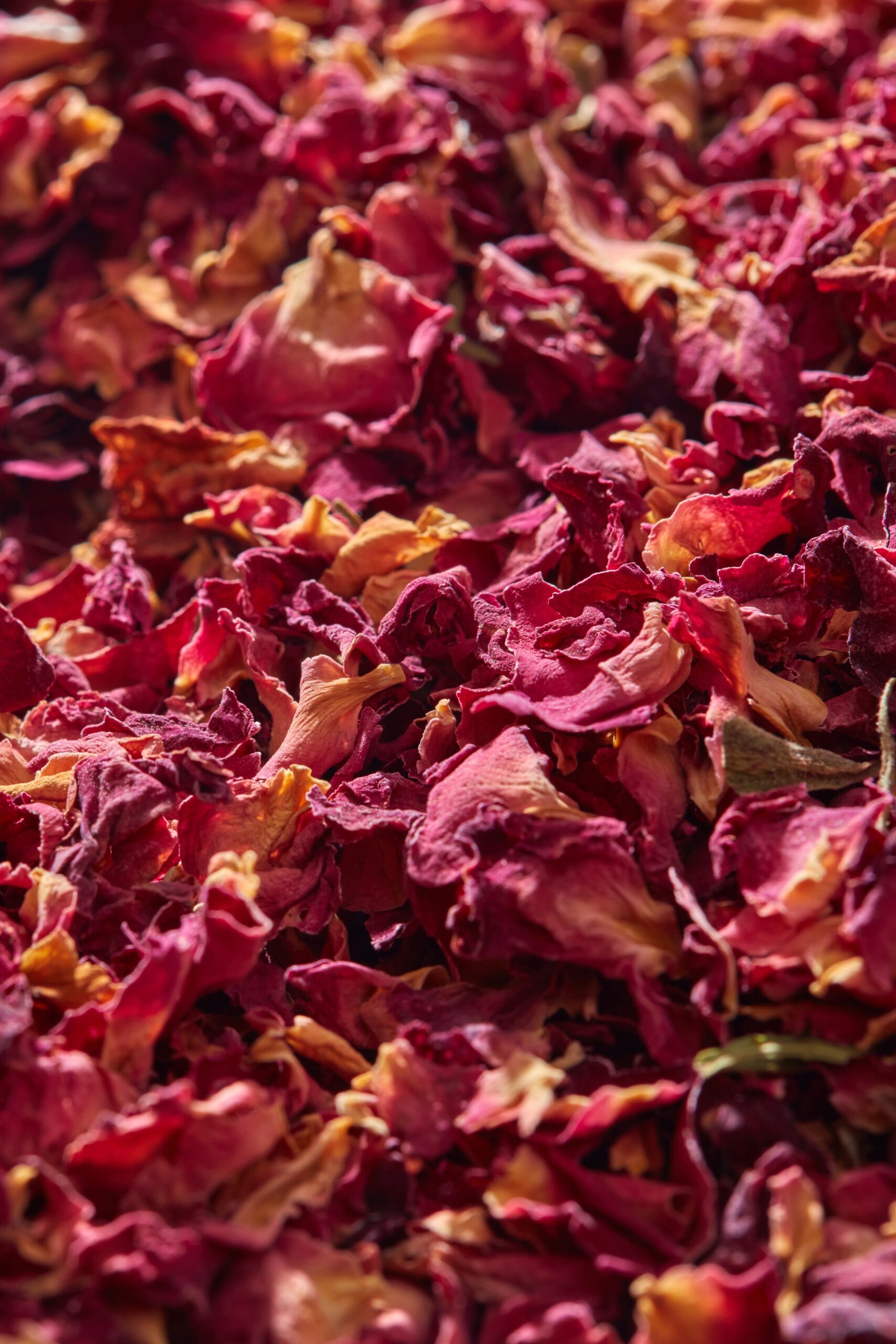
Dried rose petals are used in many cuisines and traditional preparations for their mild floral aroma and natural color. They are commonly added to desserts, herbal teas and spice blends, and are also used in home remedies and beauty routines. In India, dried rose petals appear in dishes like gulkand, biryani garnishes and festive sweets.
Drying the petals allows roses to be stored and used year-round, especially in regions where fresh roses are seasonal.
What Are Dried Rose Petals?
Dried rose petals are simply rose petals that have been air-dried or dehydrated to preserve their aroma and color. They are typically made from fragrant, pesticide-free varieties such as Damascus or desi roses. Once dried, the petals are used whole or crushed in both sweet and savory recipes, or steeped in drinks and teas.
Their flavor is subtle and slightly sweet, adding aroma without overwhelming the dish.
Quick facts
- Source: Petals of fragrant, food-safe roses
- Common varieties: Damascus rose, desi rose
- Main uses: Desserts, teas, biryani garnishes, spice blends
- Flavor: Mild, floral and slightly sweet
- Form: Whole petals or lightly crushed
- Storage: Airtight container away from light and humidity
- Why use it: Adds natural aroma and color without strong flavor
Flavor and Aroma
Dried rose petals have a light floral scent and a subtle sweetness. Their flavor is gentle rather than strong, adding aroma and visual appeal without significantly affecting taste. The exact intensity depends on the rose variety and drying conditions.
Culinary Uses
Dried rose petals are used internationally in both sweet and savory applications:
-
India: In desserts (e.g. falooda, kheer), gulkand and as a garnish
-
Iran and Middle East: In teas, rice dishes and spice blends such as advieh
-
Turkey: In confectionery like Turkish delight
-
Europe: In herbal teas, syrups and traditional preserves
-
Modern cooking: As decorative toppers for cakes, drinks and plated dishes
Their primary role is to give mild aroma, color and a visually appealing finish.
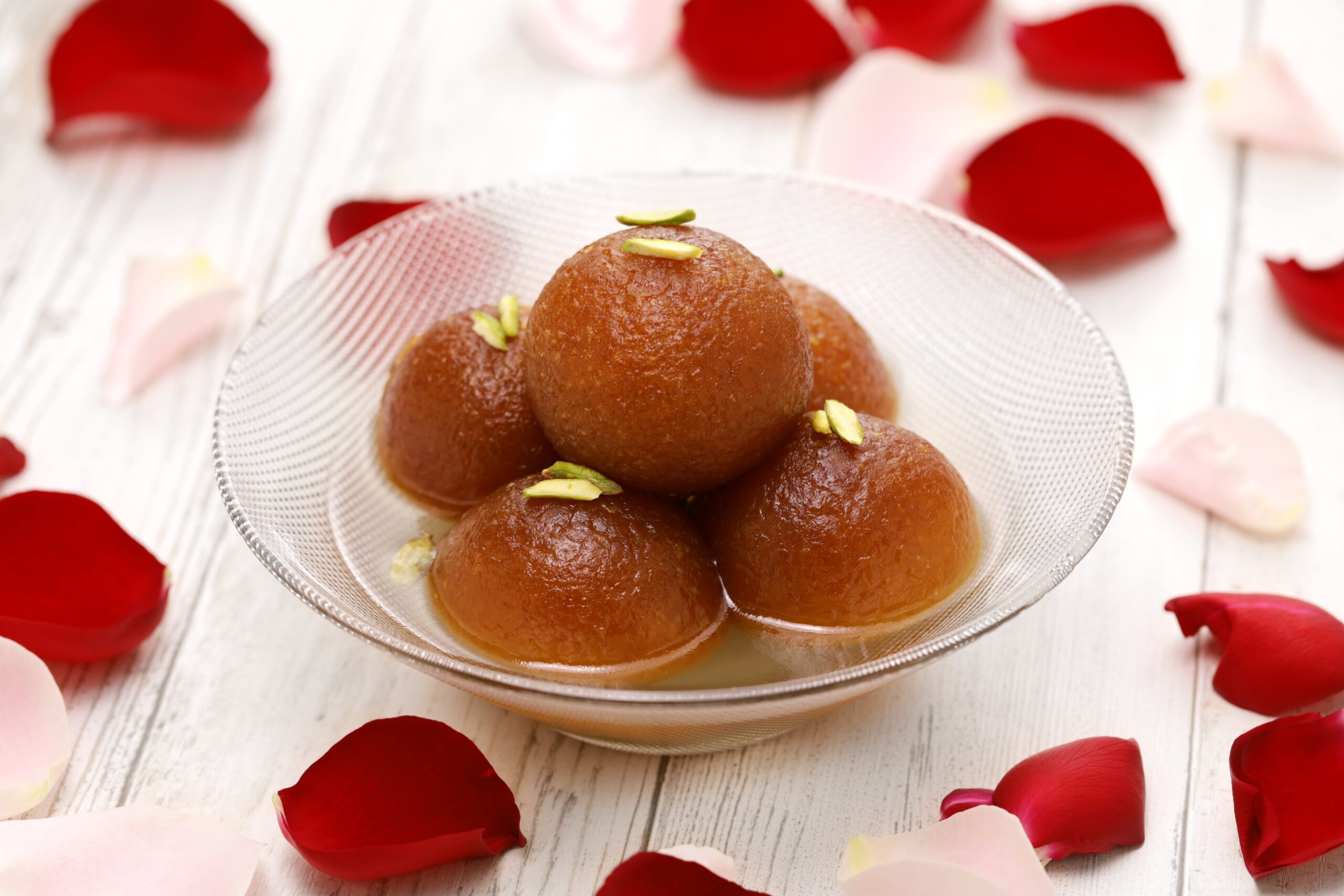
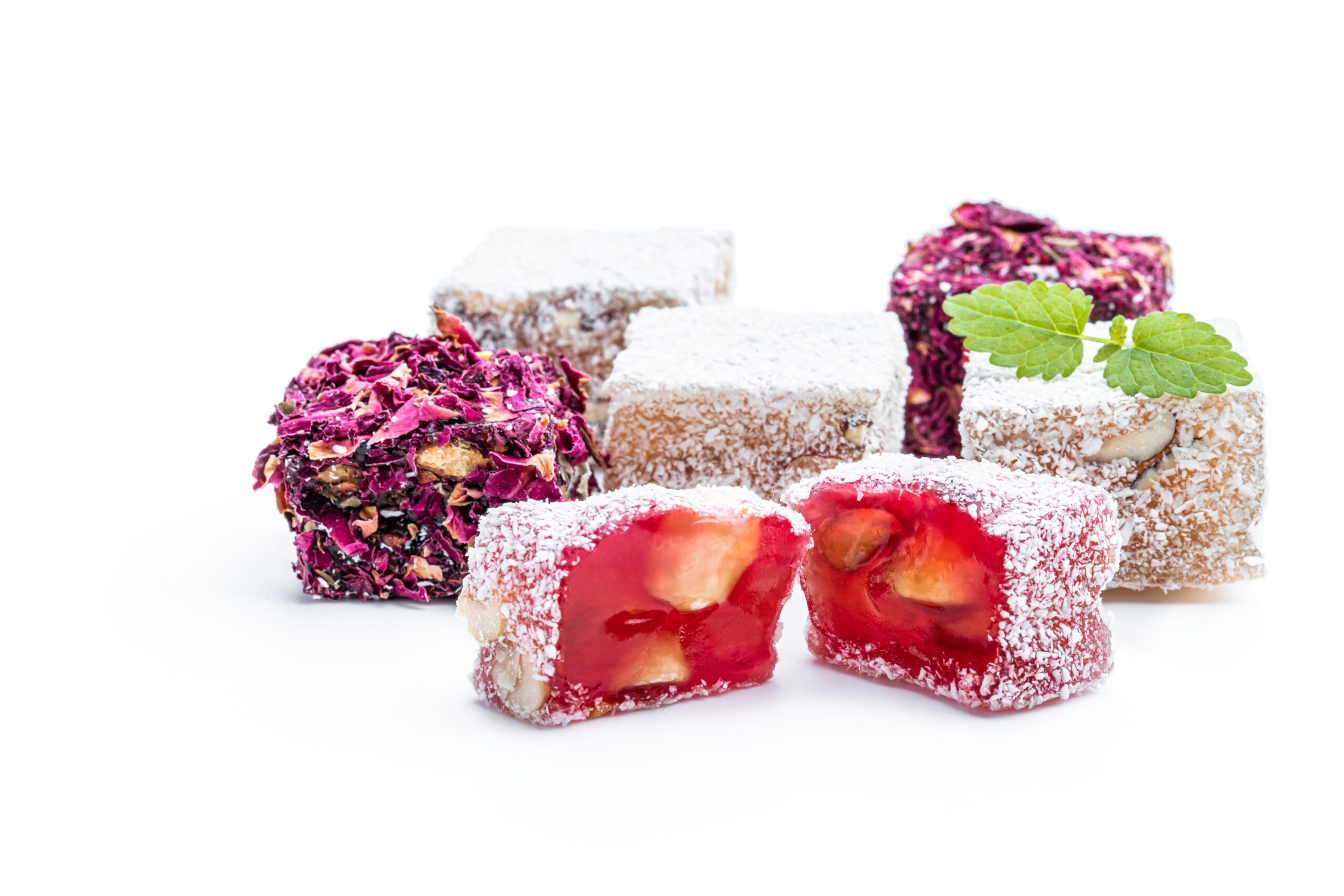

Creative Ways to Use Beyond Traditional Recipes
If you’ve only used dried rose petals in teas or desserts, you’re missing their playful side. These petals can transform everyday recipes into something unexpectedly elegant. Try these creative ideas:
-
Rose sugar or salt: Blend crushed petals with sugar or sea salt to sprinkle over cookies, shortbread, or even roasted nuts.
-
Rose-infused honey: Steep petals in warm honey for a fragrant drizzle over yogurt, pancakes, or fruit.
-
Floral butter: Mix finely crushed petals into softened butter for a delicate spread that pairs beautifully with scones or croissants.
-
Rose petal syrup: Simmer petals with sugar and water for a soft pink syrup that sweetens lemonades, mocktails, or iced teas.
-
Edible garnish: Add a few petals over cheesecakes, puddings, or salads for color and subtle perfume.
Small touches like these turn simple dishes into experiences that feel special without trying too hard.
Quick Tips to Get the Best Out of it
A few small tweaks can make your dried rose petals taste fresher, look brighter, and last longer:
-
Choose wisely: Pick petals that are naturally dried and free of added color or fragrance.
-
Revive the aroma: Gently crush them between your fingers before adding to teas or desserts.
-
Infuse, don’t overheat: Soak petals in warm—not boiling—liquid to preserve their delicate scent.
Flavor Pairings
Dried rose petals pair best with ingredients that highlight their gentle sweetness rather than compete with it. Think soft, aromatic, and slightly nutty flavors that let the floral notes shine.
-
Spices: Cardamom, saffron, cinnamon, and star anise complement rose beautifully in desserts and teas.
-
Nuts: Pistachios, almonds, and cashews add earthy depth that balances the perfume-like sweetness.
-
Fruits: Strawberries, lychees, mangoes, and pomegranates enhance its fruity undertones.
-
Sweeteners: Honey, jaggery, and vanilla sugar work better than plain sugar for a natural finish.
-
Dairy: Milk, cream, and yogurt carry rose flavor effortlessly in puddings, lassis, and ice creams.
Together, these pairings create harmony; floral, sweet, and softly spiced in every spoonful or sip.
Substitutes of Dried Rose Petals
If you can’t find dried rose petals, a few close alternatives can capture their floral charm and soft sweetness:
-
Rose water: A few drops add similar fragrance in desserts, drinks, and baked goods. Use sparingly to avoid overpowering.
-
Rose essence or extract: Stronger than rose water, ideal for flavoring syrups, frostings, and custards.
-
Hibiscus petals: Offer tart floral notes and a vivid pink color, great for teas and jams.
-
Lavender buds: Milder but aromatic; perfect for cookies, herbal teas, and infused honey.
-
Chamomile flowers: Subtle, sweet, and calming—best for herbal blends or light desserts.
Each substitute brings its own personality, but all echo the delicate beauty that makes dried rose petals so timeless.
Dried Rose Petals in Traditional Remedies
Across centuries, dried rose petals have been used not just for their fragrance but for their healing touch. In Ayurveda, Unani, and folk medicine, they’re seen as cooling, calming, and rejuvenating.
-
Soothing tea: Steep dried petals to ease stress, headaches, and fatigue while gently supporting digestion.
-
Rose-honey mix: Crushed petals blended with honey or ghee were used to calm sore throats and mild inflammation.
-
Eye and skin care: Rose-infused water helped reduce eye strain, redness, and irritation while refreshing tired skin.
-
Aromatherapy: Rose oil or infused petals massaged onto the temples were believed to relax the mind and uplift mood.
-
Herbal tonics: Modern herbalists use rose teas for hydration, skin health, and mild detox, thanks to their antioxidants.
Each remedy shows how roses have long been trusted as symbols of balance and comfort; healing the body and softening the spirit.
How to Store It Right
Dried rose petals stay fragrant and colorful for months when stored with a little care. Their biggest enemies are moisture, sunlight, and strong odors.
-
Use airtight jars: Glass containers with tight lids preserve aroma better than plastic.
-
Keep away from sunlight: Store in a cool, shaded cupboard to prevent fading.
-
Avoid humidity: Even a little moisture can cause mold or dullness—add a small silica packet if needed.
-
Don’t crush early: Keep petals whole until use to retain fragrance and color.
-
Label and date: Note the storage date; most petals stay fresh for up to six months.
Handled gently, your dried rose petals will keep their soft scent and color, ready to infuse recipes, teas, or crafts any time you wish.
Nutritional Value (Per Tablespoon – Approx. 2 Grams)
Dried rose petals are light and fragrant, so even a tablespoon adds subtle wellness benefits without extra calories.
-
Calories: ~2 kcal
-
Carbohydrates: ~0.3 g
-
Protein: ~0.1 g
-
Fat: ~0.02 g
-
Vitamin C: ~3–5 mg (varies by rose variety)
-
Antioxidants: Rich in polyphenols and flavonoids that protect cells from oxidative stress.
-
Fiber: Trace amounts that gently support digestion.
While they’re not a major nutrient source, their antioxidant power and natural vitamin C content make them a lovely way to add gentle nourishment to teas, desserts, or skincare infusions.
Health Benefits
Dried rose petals offer gentle health support that blends tradition with modern wellness insights. Their nutrients may be light, but their effects are soothing and steady.
-
Supports digestion: Rose tea can help relieve mild bloating, acidity, and stomach discomfort.
-
Promotes relaxation: The floral aroma is known to ease stress and uplift mood, making it ideal for winding down.
-
Aids hydration: Rose-infused water or tea replenishes fluids and adds a cooling, refreshing effect.
-
Menstrual relief: In traditional remedies, rose tea has been used to help reduce mild cramps and fatigue.
-
Natural detox: Mild diuretic properties support kidney function and help flush toxins gently.
Soft on the senses yet steady in effect, dried rose petals bring a touch of balance and calm reminding us that wellness can be both fragrant and simple.
Dried Rose Petals for Skincare and Natural Beauty
For centuries, dried rose petals have been at the heart of natural beauty rituals. Their gentle aroma, vitamins, and antioxidants make them a simple yet luxurious way to care for the skin.
-
Soothing toner: Boil petals in water to create a mild rose toner that cools, refreshes, and balances the skin.
-
Brightening face mask: Mix rose petal powder with yogurt or honey to help hydrate and restore glow.
-
Bath soak: Add petals to warm water for a calming, aromatic bath that softens the skin and eases tension.
-
Lip and body scrubs: Combine crushed petals with sugar and coconut oil for gentle exfoliation and natural fragrance.
-
Under-eye refresh: Soak cotton pads in rose-infused water to reduce puffiness and revive tired eyes.
Their soft fragrance soothes the mind while their nutrients care for the skin, a timeless blend of self-care and serenity.

Potential Health Risks
Dried rose petals are generally safe when used in small culinary or herbal amounts, but a few precautions are worth keeping in mind:
-
Pesticide exposure: Always choose petals from organically grown roses. Decorative roses may contain chemical residues unsafe for consumption.
-
Allergic reactions: Though rare, some people may experience mild itching or irritation from rose pollen or fragrance compounds.
-
Excessive use: Large amounts of rose tea may cause mild stomach upset or nausea due to its natural tannins.
-
Pregnancy and breastfeeding: Limited research exists on heavy consumption during these stages, so moderation is safest.
-
Contamination risk: Improperly dried or stored petals can develop mold, reducing both flavor and safety.
In moderate, well-sourced amounts, dried rose petals are gentle and safe. A little mindfulness in choosing and storing them keeps their beauty and your wellbeing intact.
Final Thoughts
Dried rose petals offer a simple way to add mild floral aroma and natural color to food and drinks. They are easy to store, versatile and widely used in traditional and modern recipes. Choosing food-safe, untreated petals helps ensure good flavor and safe consumption. Whether used in teas, desserts or garnishes, dried roses provide subtle enhancement rather than strong sweetness, making them a practical ingredient to keep in the pantry.
FAQs
Are all dried rose petals edible?
No. Only food-grade petals that are free from pesticides and artificial fragrances are safe to eat.
Can dried rose petals go bad?
They don’t spoil quickly, but they can lose color and aroma over time. Store airtight in a cool, dark place and use within 6–12 months for best results.
How many petals should I use in teas or desserts?
A small amount is enough. Start with a teaspoon of crushed petals per serving and adjust to taste.
Do dried petals taste like fresh roses?
The flavor is milder. They add more aroma and visual appeal than strong taste.
Can I grind them into a powder at home?
Yes. Fully dried petals can be ground using a clean spice grinder, then sifted to a fine powder.
Any ingredients that pair well with dried roses?
Cardamom, saffron, pistachio, cinnamon and vanilla complement the floral aroma especially in sweets and drinks.
Learn More About Dried Rose Petals
LinsFood—How to Cook with Rose Petals
This article discusses the culinary and decorative uses of edible dried rose petals, explaining how to safely select, prepare, and use them in global cuisines. It also highlights creative recipe ideas such as rose sugar, provides serving suggestions for drinks and desserts, and offers practical storage and sourcing tips for maintaining their fragrance and color.



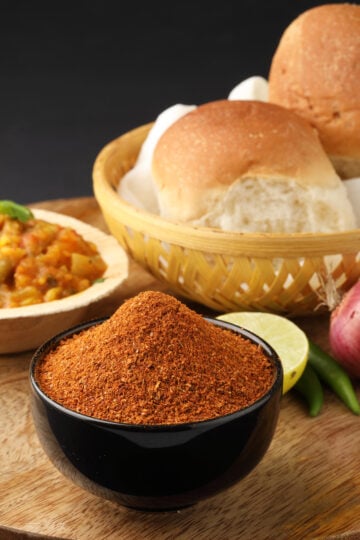
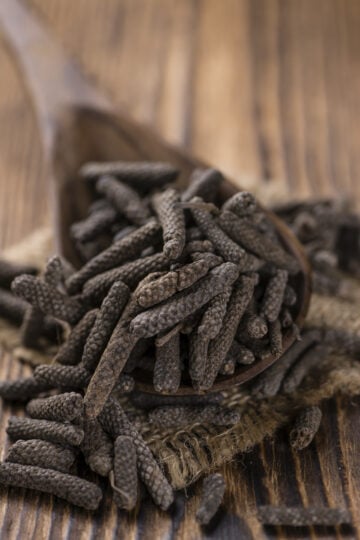
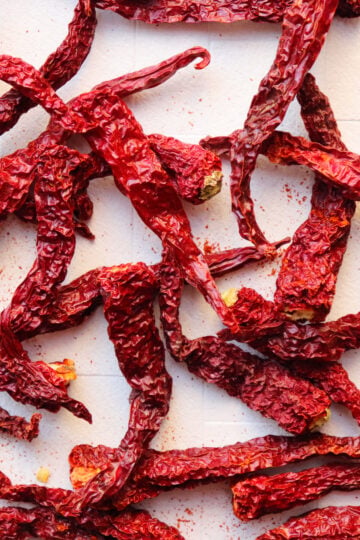
Have a question or something to share? Leave a comment below!